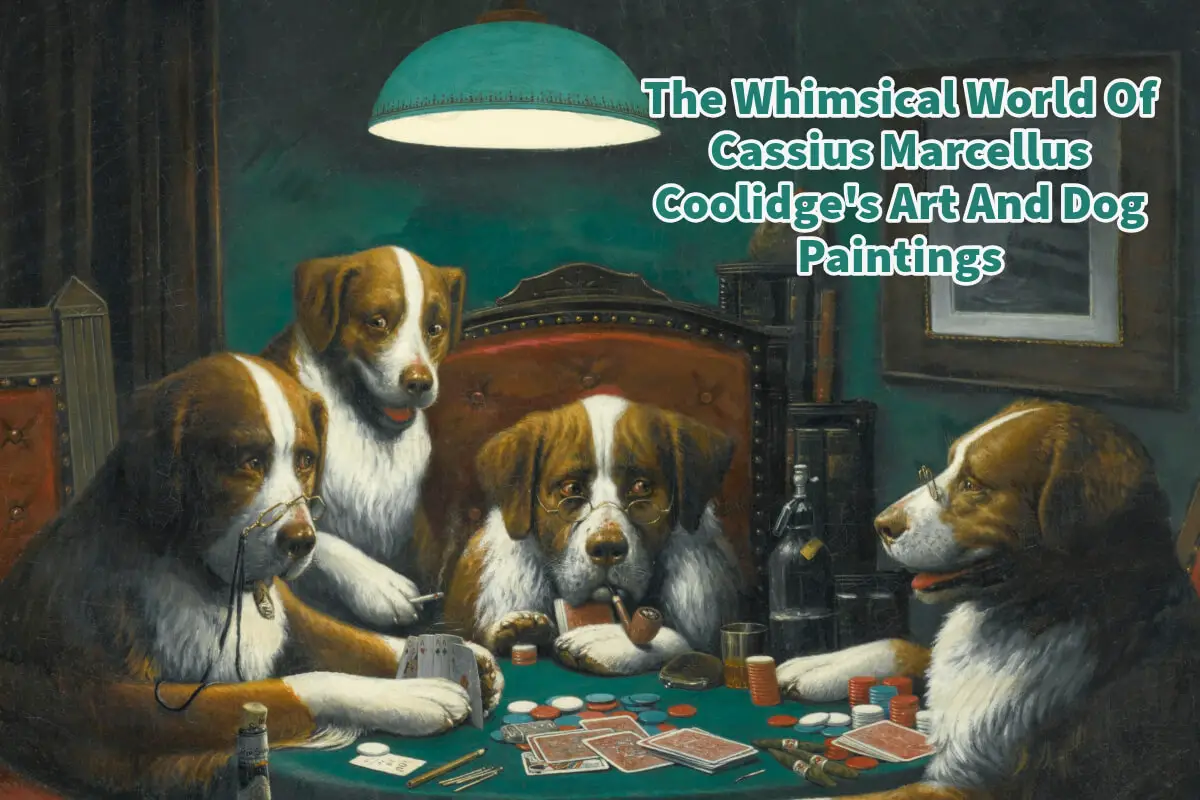Cassius Marcellus Coolidge, synonymous with quirky, endearing paintings of dogs playing poker, has carved a unique niche in American art history. Anyone who is a dog lover – as I am – has probably seen his paintings.
Cassius Marcellus Coolidge’s series of paintings, capturing anthropomorphized dogs engaged in various human activities, particularly poker games, has not only entertained art lovers but also left an indelible mark on popular culture. Read on as we explore the life, works, and enduring legacy of Coolidge, affectionately known as “Cash.”
Table of Contents
- Early Life And Career Of Cassius Marcellus Coolidge
- Cassius Marcellus Coolidge’s – The Dogs Playing Poker Series
- Related Questions
Early Life And Career Of Cassius Marcellus Coolidge
Born in 1844 in Antwerp, New York, Cassius Marcellus Coolidge led a life as colorful and varied as his future paintings. His early years in the rural setting of upstate New York were marked by a burgeoning curiosity and a penchant for creativity that would define his eclectic career path.
Despite the limited educational opportunities in rural 19th-century America, Coolidge was largely self-taught, demonstrating an innate talent for observation and the arts.
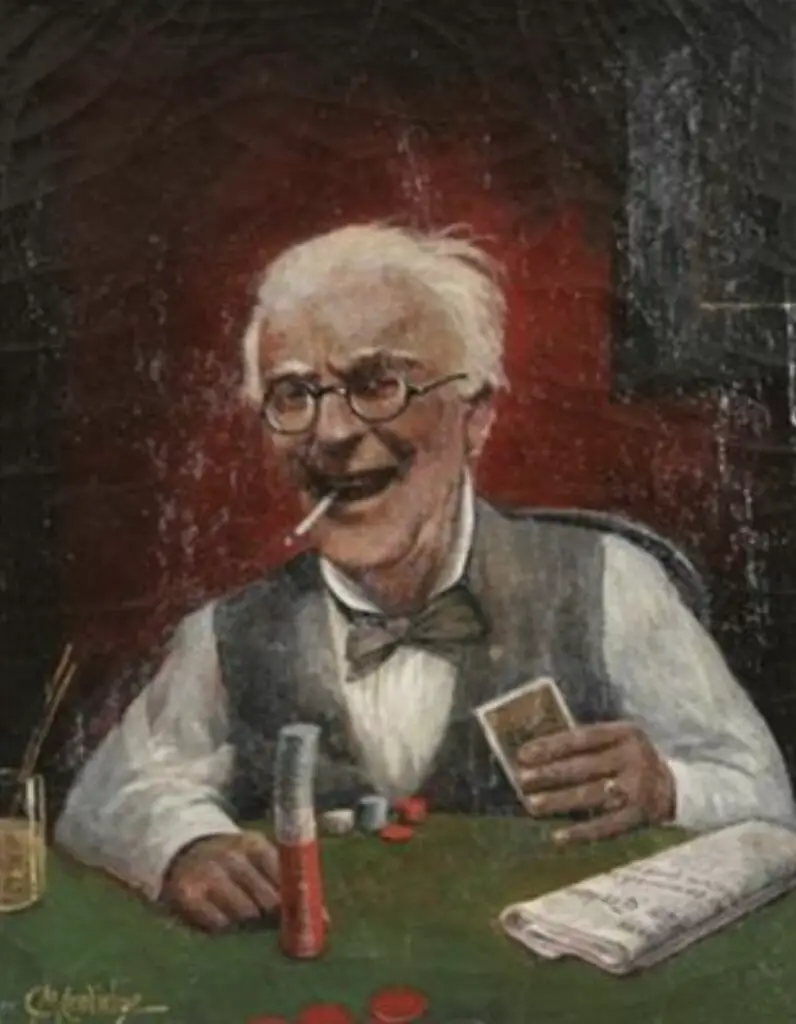
Coolidge Was A Self Taught Artist
Coolidge’s career trajectory was anything but linear. Initially, he tried his hand at banking—a job that showcased his analytical skills but perhaps did not fully satisfy his creative urges. His entrepreneurial spirit soon led him to venture into newspaper publishing.
He founded his newspaper, the “Antwerp News,” which was an outlet for his early artistic expressions and satirical writings. This experience not only honed his communication skills but also sparked his interest in illustration, which would play a significant role in his later career.
His move from banking and publishing into art wasn’t abrupt. Instead, it was a gradual transition facilitated by his growing interest in commercial advertising.
Coolidge Started To Create Cartoons And Illustrations
Coolidge began creating cartoons and illustrations for various advertisements, newspapers, and children’s books. His work in this arena was marked by a distinctive style of humor and inventive visuals, which caught the attention of the public and commercial patrons alike. Through these ventures, he started to gain recognition, carving a niche for himself in the artistic community.
Coolidge Developed A Unique Artistic Style
During this period, Coolidge developed a unique artistic style characterized by its whimsy and a focus on anthropomorphic animals, particularly dogs. This signature style would later become the cornerstone of his most famous series of paintings, “Dogs Playing Poker.
Beyond his artistic pursuits, Coolidge was known for his inventions; he held patents for several devices, including a life-sized cutout of people called Comic Foregrounds, which were popular at carnivals, allowing people to stick their heads atop cartoon bodies for humorous photo opportunities—a testament to his inventive mind and sense of humor.
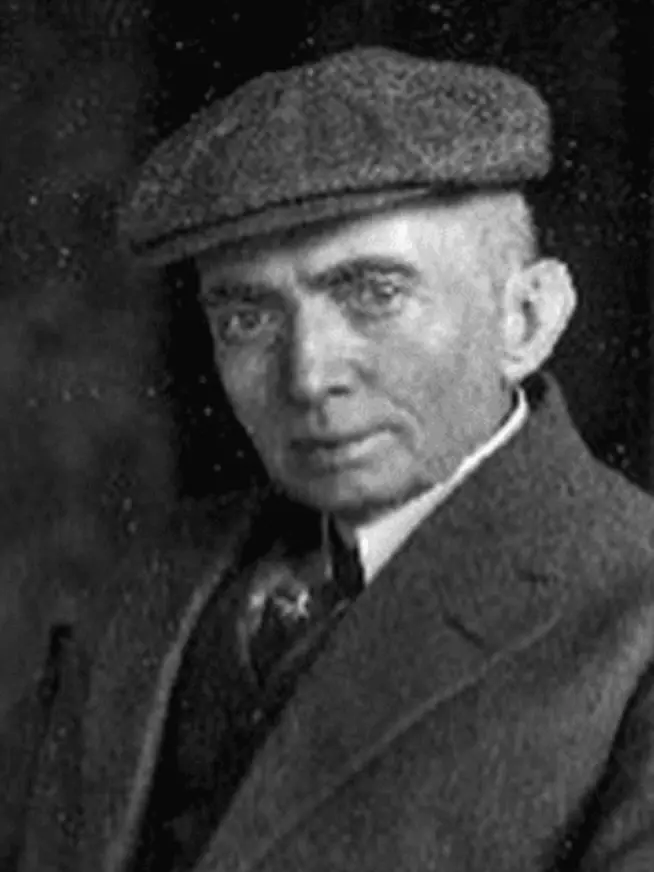
Cassius Marcellus Coolidge’s – The Dogs Playing Poker Series
Coolidge’s most famous works, the “Dogs Playing Poker” series, were commissioned in 1903 by Brown & Bigelow to advertise cigars. The series comprises sixteen oil paintings and several other related works.
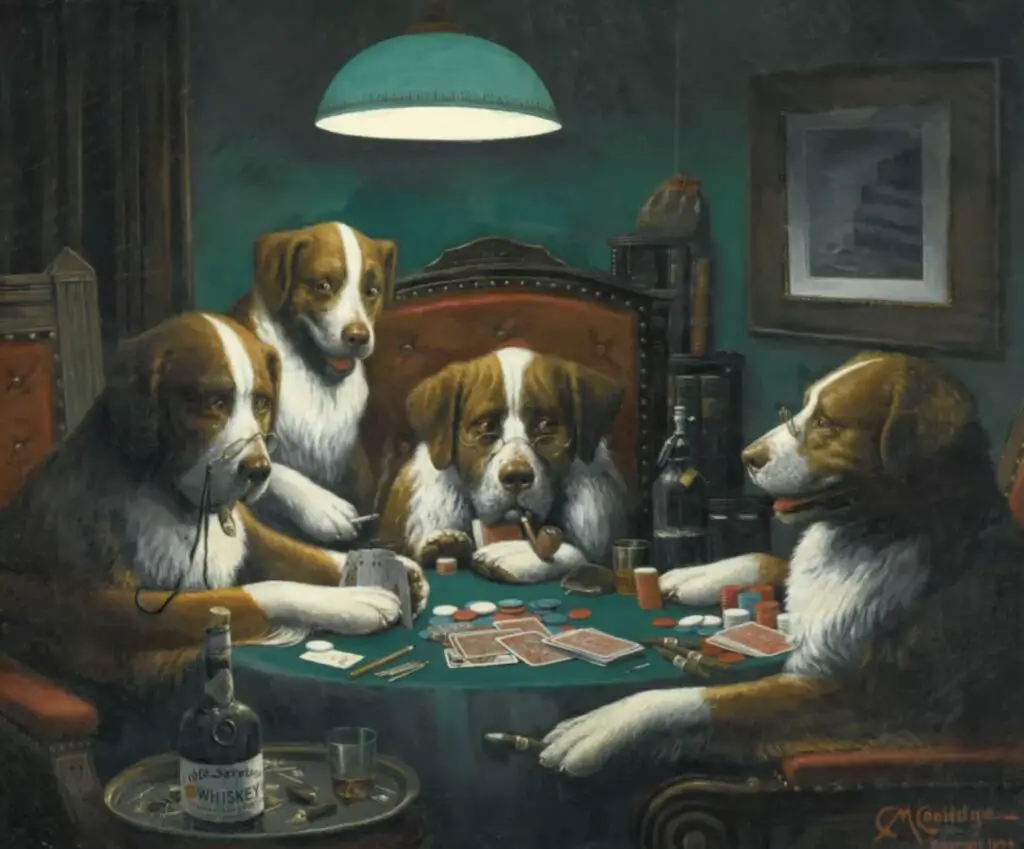
These paintings depict personified dogs dressed in human clothing, playing cards, and engaging in other typically human activities, effectively capturing the absurdity and charm that would appeal to the masses.
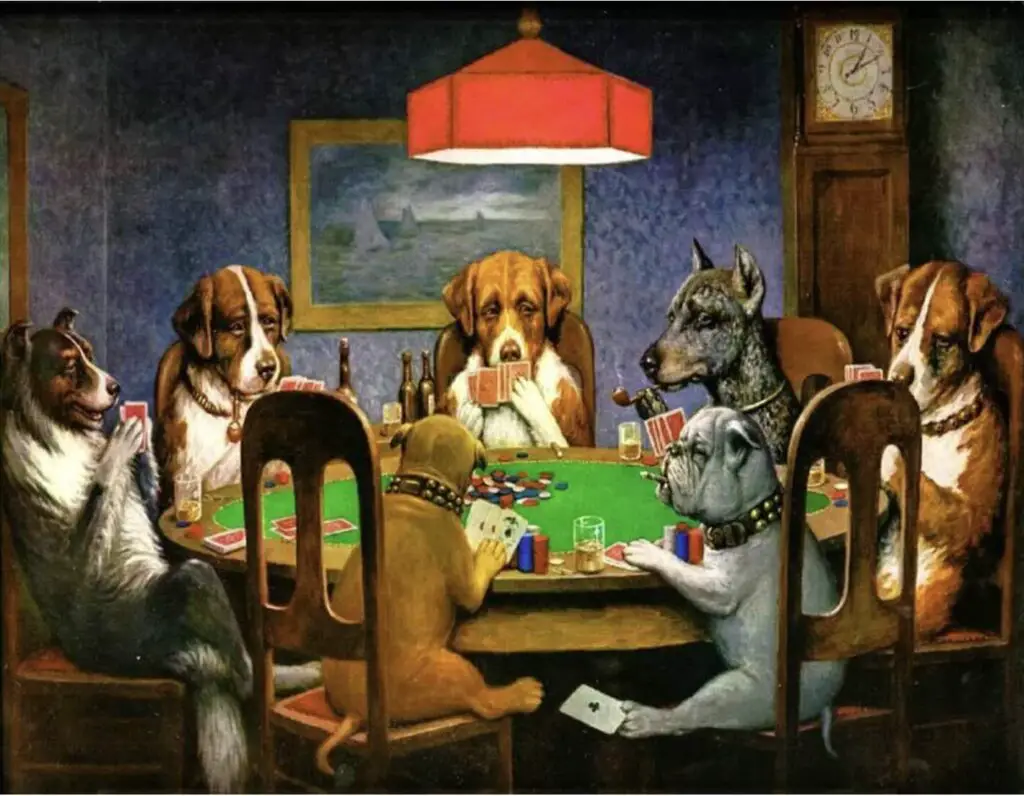
The series includes titles like A Friend in Need, Poker Sympathy, and Pinched with Four Aces. Each painting tells a story, often with a humorous twist, reflecting Coolidge’s keen sense of wit and observation.
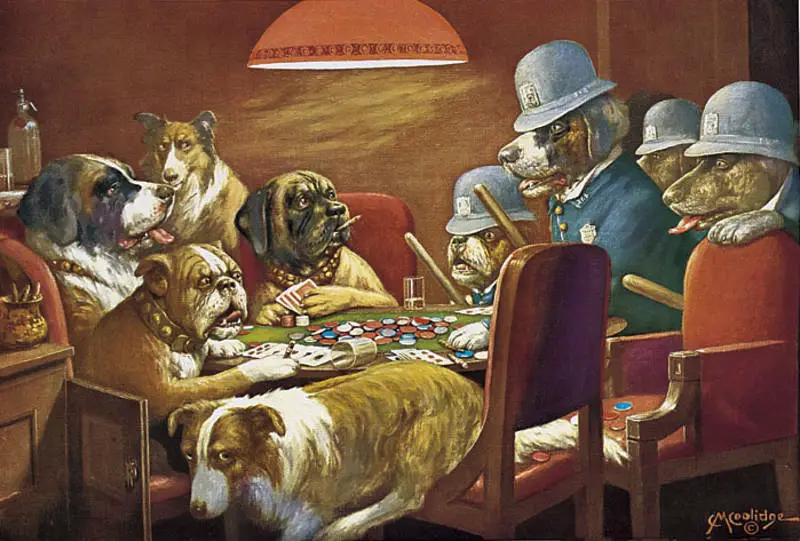
The anthropomorphic portrayal of the dogs was not only unique but also a satirical comment on human behavior—especially the behaviors seen around poker tables.
Artistic Style And Influence
Coolidge’s style is often characterized by its bold colors, meticulous attention to detail, and a distinctively whimsical approach to subject matter. His ability to infuse life and personality into his canine characters won him admiration and critique.
While some critics dismissed his work as mere novelty, others recognized the cleverness and originality in his approach to satirizing human foibles.
Legacy And Popularity
Coolidge’s whimsical and surreal style has allowed his work to transcend traditional art boundaries and become iconic in pop culture. His images have been reproduced on countless merchandise, from posters and T-shirts to mugs and playing cards, attesting to their widespread appeal.
Moreover, “Dogs Playing Poker” has influenced not only art but also television, film, and literature. It is often referenced and parodied for its easily recognizable tableau and inherent humor. The paintings have also become favorites in American households, often viewed with nostalgia and amusement.
Cassius Marcellus Coolidge’s contribution to art might not be conventional, but it is undoubtedly unforgettable. His imaginative renderings of dogs playing poker have brought smiles and prompted viewers to reflect on the human condition—albeit in a light-hearted and approachable manner.
In the art world, where the profound and the profound often take center stage, Coolidge’s work reminds us of the joy and simplicity art can bring into our lives. His legacy continues to endure, proving that sometimes, art is best enjoyed with a little bit of whimsy and a lot of heart.
Cassius Marcellus Coolidge’s journey from a banker and newspaper publisher to a renowned artist and humorist illustrates the unpredictable path of creative careers, especially when the arts rapidly evolved alongside the industrial and social changes of late 19th—and early 20th-century America.
His life and work continue to fascinate and entertain, embodying the spirit of American ingenuity and the timeless appeal of art that doesn’t take itself too seriously.
Listen To Our Podcast About What Makes Cassius Marcellus Coolidge’s Dog Paintings So Timeless? Below or By clicking here.
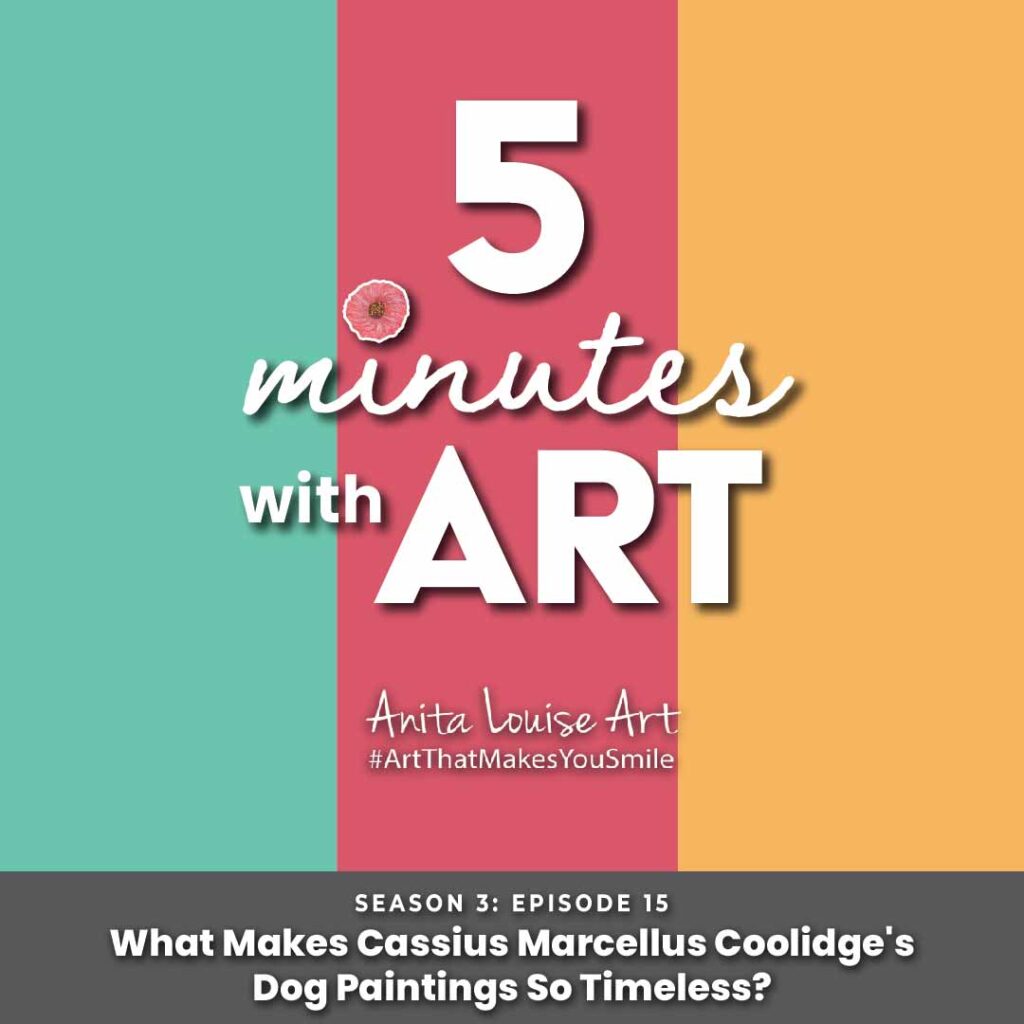
Anita Louise Art is dedicated to art education, great artists, and inspiring others to find and create their art. We love art that uplifts and inspires. #ArtToMakeYouSmile! #ArtToMakeYouHappy!
If you are interested to see any of my art, you can find out more by clicking here. If you are interested in what inspires me and my paintings, you can discover more by clicking here.
We have a free newsletter and would love you to be part of our community; you can subscribe to the newsletter by clicking here. If you have any questions, I would be happy to talk to you. You can reach me, Anita, by clicking here.
Subscribe to our Anita Louise Art YouTube Channel filled with great videos and information by clicking here.
Join us for our podcast “5 Minutes With Art.” Spend just 5 minutes a week with us to discover and learn about great art and artists. You can find out more about our podcast by clicking here.
Related Questions
Picking Flower, By Anita Louise Hummel, An Original Dog Oil Painting
Picking Flowers by Anita Louise Hummel is an original oil painting. The dog is black and white, so I painted a bright yellow background to compliment the dog’s natural black and white coloring. The pink flower hanging from his mouth symbolizes a flower that he mischievously picked in the garden that he should not have.
By clicking here, you can learn more by reading Picking Flower, By Anita Louise Hummel, An Original Dog Oil Painting.
The Selfie, By Anita Louise Hummel – Even Dogs Can Take Selfies
The Selfie is an original oil painting by Anita Louise Hummel. This oil painting is medium to bright oil paints of a dog holding his phone and showing us the selfie he has just taken. The painting is, in part, asking the question, “if our dogs could take a selfie, what kind of selfie would they take?”
By clicking here, you can learn more by reading The Selfie, By Anita Louise Hummel – Even Dogs Can Take Selfies.
Henriette Ronner-Knip (1821-1909), Painter of Cats & Dogs
Henriette Ronner-Knip came from a family of artists. She became in charge of the family’s finances and other legal obligations at an early age, so she started to paint. She sold her first painting at the age of 15-year-old. Later, when she was married, Her husband became her manager, and Henriette continued to paint. She is famous for her many beautiful paintings of cats and dogs. She chooses to paint dogs and cats as subject matter because, during the Victorian era, having a pet in your household was popular.
You can learn more by reading Henriette Ronner-Knip (1821-1909), Painter of Cats & Dogs by clicking here.

